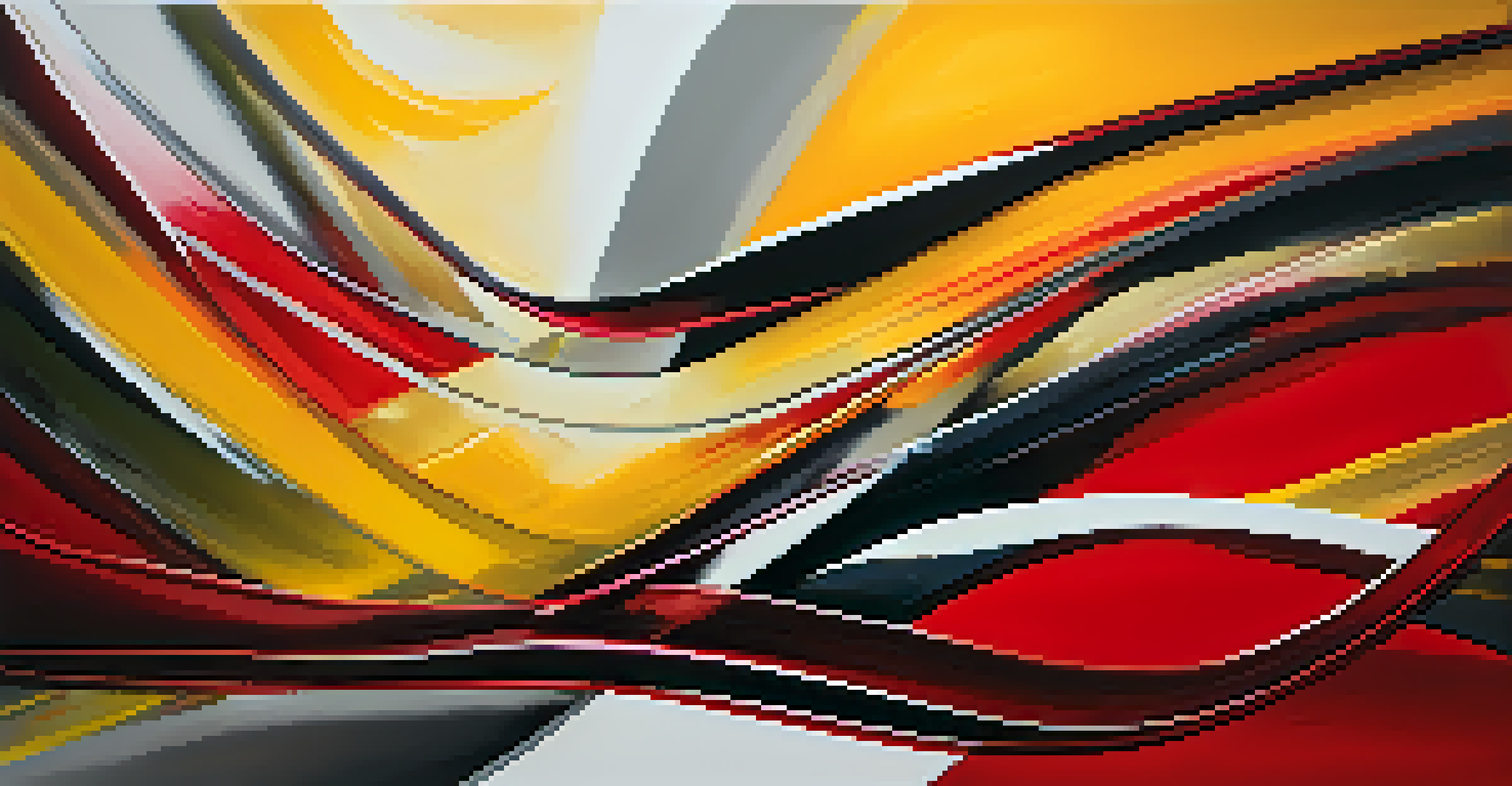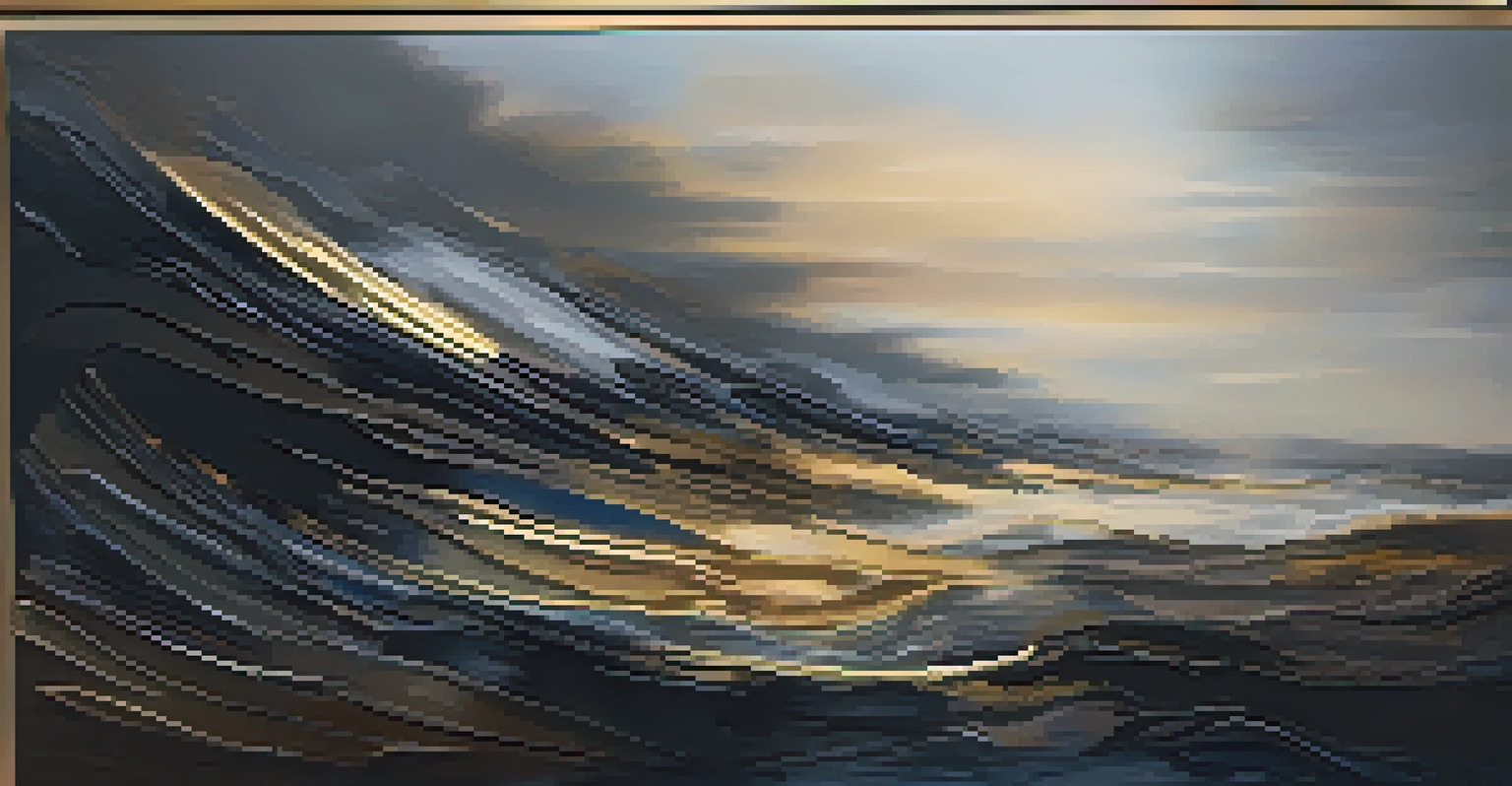Colors as Narrators: The Language of Abstract Painting

Understanding Abstract Painting and Its Unique Language
Abstract painting breaks away from traditional representation, focusing instead on color, form, and emotion. This style allows artists to express feelings and ideas without the constraints of realistic depictions. The beauty of abstract art lies in its openness; each viewer interprets the colors and shapes in personal ways, forming their narrative.
Color is the keyboard, the eyes are the harmonies, the soul is the piano with many strings.
In this realm, colors take on a life of their own, communicating a range of emotions and thoughts. For instance, a vibrant red might evoke passion or anger, while a soothing blue can bring about feelings of calmness and serenity. This emotional vocabulary of colors makes abstract painting a unique conversation starter between the artwork and the viewer.
Thus, abstract painting serves as a visual language, where colors act as narrators, telling stories that transcend words. By understanding this language, we can appreciate the depth of feelings and thoughts that artists convey through their chosen palette.
The Emotional Palette: Colors and Their Meanings
Colors are powerful symbols that resonate deeply with our emotions. For example, yellow often signifies joy and optimism, while green is frequently associated with growth and renewal. By examining these emotional connections, we can gain insight into the artist's intentions and the messages they wish to convey.

Artists strategically select colors to evoke specific reactions from their audience. A canvas splashed with contrasting colors can create tension, while harmonious hues may evoke a sense of peace. This interplay of colors not only enhances the visual experience but also deepens the emotional impact of the artwork.
Abstract Art: A Personal Journey
Abstract painting allows viewers to interpret colors and forms in unique ways, creating personal narratives that resonate with their emotions.
Understanding the emotional meanings behind colors can enrich our viewing experience. As we learn to recognize these associations, we become more attuned to the stories that abstract paintings tell, allowing us to engage with the art on a more profound level.
Symbolism in Color Choices: A Deeper Look
Beyond their emotional resonance, colors in abstract paintings often carry deeper symbolic meanings. For example, black can represent mystery or the unknown, while white might symbolize purity and simplicity. The artist's choice of color can thus reflect broader themes and ideas, inviting viewers to explore these concepts further.
Art is the most beautiful of all lies; it is the dream of reality.
This symbolic layer adds complexity to the narrative conveyed by the artwork. When we consider the context in which the colors are used, we can begin to unravel the intricate stories hidden within the brushstrokes. The artist's background, cultural influences, and personal experiences often shape these symbols.
By delving into the symbolism of colors, we unlock new interpretations of abstract art. Each color choice becomes a piece of the puzzle, leading us toward a richer understanding of the artist's message and the emotions they seek to share.
The Role of Contrast and Harmony in Storytelling
In abstract painting, contrast and harmony play pivotal roles in shaping the narrative. Contrasting colors, like red and green, can create a sense of tension or conflict, while harmonious colors, such as blue and green, promote unity and peace. This dynamic interplay not only captures the viewer's attention but also guides their emotional response.
Artists often use these elements to narrate stories visually. For instance, a piece that juxtaposes dark and light colors might depict a struggle or a journey from despair to hope. The viewer is invited to interpret the narrative based on their emotional reactions to these contrasting elements.
Colors as Emotional and Symbolic Tools
Colors in abstract art carry emotional meanings and deeper symbolic significance, enhancing the viewer's understanding and connection to the artwork.
Thus, understanding how contrast and harmony function within abstract art enhances our appreciation of the storytelling aspect of colors. As we navigate these visual paths, we discover the depth of emotions and experiences that the artist aims to communicate.
Personal Interpretations: The Viewer’s Perspective
One of the most captivating aspects of abstract painting is the personal interpretation it invites from viewers. Each individual brings their own experiences, emotions, and perspectives to the artwork, which can lead to a multitude of interpretations. This subjective nature encourages a dialogue between the viewer and the painting, creating a unique connection.
For example, a viewer might see a chaotic swirl of colors as a representation of their own inner turmoil, while another might interpret it as a celebration of life’s vibrancy. This diversity in interpretation showcases the power of colors as narrators, allowing them to resonate differently with each observer.
Ultimately, the viewer's perspective enriches the narrative of the abstract piece. By sharing our interpretations and experiences, we contribute to the ongoing dialogue that colors inspire, making abstract art a collective exploration of emotions and stories.
The Influence of Cultural Context on Color Perception
Cultural context plays a significant role in how colors are perceived and interpreted in abstract art. Different cultures associate various meanings and emotions with specific colors, which can influence both the artist's choices and the viewer's understanding. For example, while white symbolizes purity in many Western cultures, it is often associated with mourning in some Eastern traditions.
This cultural lens adds layers of complexity to the interpretations of abstract paintings. When we view a piece of art, understanding its cultural background can provide insight into the artist’s intentions and the emotions they aim to evoke. It encourages us to consider how our own cultural experiences shape our perceptions.
Cultural Context Shapes Color Perception
Cultural backgrounds influence how colors are perceived in abstract art, adding layers of meaning that enrich the viewing experience.
By acknowledging the influence of cultural context, we can engage with abstract art on a deeper level. We become more aware of the rich tapestry of meanings and emotions that colors can convey, allowing for a more nuanced appreciation of the artwork.
The Future of Color in Abstract Art: Trends and Innovations
As we move forward in the world of abstract art, the use of color continues to evolve. New technologies and materials are allowing artists to experiment with color in innovative ways, leading to exciting developments in the field. From digital art to mixed media, the possibilities for color application are expanding.
Contemporary artists are increasingly exploring themes related to identity, environment, and social issues through their color choices. This trend reflects a growing awareness of how colors can narrate powerful stories and convey messages that resonate with current societal challenges. As artists push boundaries, they invite viewers to engage with these themes on a personal level.

The future of color in abstract painting promises to be vibrant and diverse. As artists continue to explore new methods and meanings, we can expect to see an ongoing dialogue about the language of color, enriching our understanding of abstract art as a powerful form of expression.